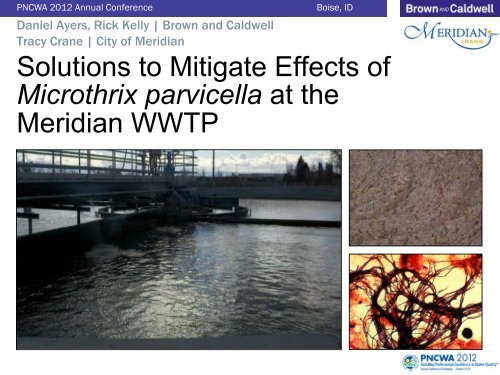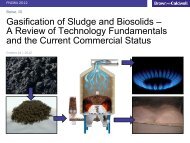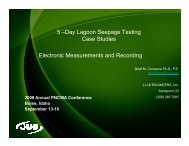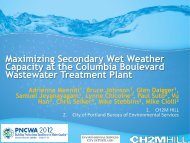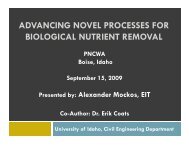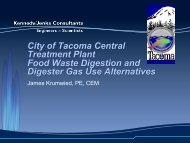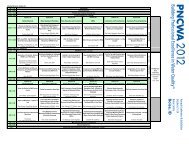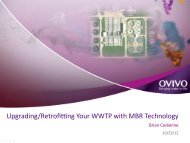Solutions to Mitigate Effects of Microthrix parvicella at the ... - pncwa
Solutions to Mitigate Effects of Microthrix parvicella at the ... - pncwa
Solutions to Mitigate Effects of Microthrix parvicella at the ... - pncwa
You also want an ePaper? Increase the reach of your titles
YUMPU automatically turns print PDFs into web optimized ePapers that Google loves.
PNCWA 2012 Annual Conference<br />
Daniel Ayers, Rick Kelly | Brown and Caldwell<br />
Tracy Crane | City <strong>of</strong> Meridian<br />
Boise, ID<br />
<strong>Solutions</strong> <strong>to</strong> <strong>Mitig<strong>at</strong>e</strong> <strong>Effects</strong> <strong>of</strong><br />
<strong>Microthrix</strong> <strong>parvicella</strong> <strong>at</strong> <strong>the</strong><br />
Meridian WWTP
Outline<br />
• Background<br />
• Meridian WWTP<br />
• Wh<strong>at</strong> is <strong>Microthrix</strong>?<br />
• Meridian’s Experiences with <strong>Microthrix</strong><br />
• Investig<strong>at</strong>ing solutions<br />
• Concluding remarks
Background
Meridian WWTP<br />
• 6 mgd ADF<br />
• Screenings, grit removal,<br />
primary clarifiers<br />
• Secondary tre<strong>at</strong>ment<br />
pump st<strong>at</strong>ion<br />
• BNR activ<strong>at</strong>ed sludge<br />
secondary tre<strong>at</strong>ment<br />
• UV disinfection, filtr<strong>at</strong>ion<br />
for reclaimed w<strong>at</strong>er<br />
• Mesophilic anaerobic<br />
digestion
Wh<strong>at</strong> is <strong>Microthrix</strong> Parvicella (MP)?<br />
-Bête noir <strong>of</strong> filaments<br />
• Gram positive, un-branched filament<br />
• Surveys in many countries show MP<br />
domin<strong>at</strong>es bulking sludges and foams<br />
• Favored by:<br />
• Long SRTs (BNR Plants)<br />
• Altern<strong>at</strong>ing aer<strong>at</strong>ed/ non-aer<strong>at</strong>ed<br />
zones (BNR plants)<br />
• Foam trapping environments<br />
• Low T (Winter/Spring)<br />
• Long Chain F<strong>at</strong>ty Acids (LCFA) food<br />
source (FOG)<br />
Gram Stain - x1000<br />
MP foam
Why is <strong>Microthrix</strong> a Problem?<br />
• Foaming<br />
• Aes<strong>the</strong>tics<br />
• Carryover <strong>to</strong> effluent<br />
• Breeding ground for filaments<br />
• Digester foaming<br />
• Poor Settling<br />
• Form<strong>at</strong>ion <strong>of</strong> high sludge blankets<br />
• High effluent TSS<br />
• Loss <strong>of</strong> Clarifier capacity<br />
• Requires low SRT <strong>to</strong> wash out or<br />
chemicals <strong>to</strong> kill<br />
• Nitrific<strong>at</strong>ion can be a problem with<br />
both solutions<br />
Bulking sludge overflowing clarifier<br />
Brown and Caldwell 6
Meridian <strong>Microthrix</strong> Issues<br />
Seasonal MP blooms (winter and<br />
spring) lead <strong>to</strong>:<br />
• <strong>Microthrix</strong> bulking = reduced<br />
capacity <strong>of</strong> clarifiers<br />
• <strong>Microthrix</strong> foam leads <strong>to</strong> high<br />
TSS = increased filter<br />
backwashing<br />
Biological foam on AS basin
Meridian <strong>Microthrix</strong> Control Methods<br />
• Reduce SRT and/or add<br />
chlorine for bulking<br />
control<br />
• Inhibited nitrific<strong>at</strong>ion<br />
• Increased effluent TSS<br />
• High effluent TSS =<br />
reduced tertiary filter<br />
capacity<br />
• No nitrific<strong>at</strong>ion = no<br />
reclaimed w<strong>at</strong>er<br />
production<br />
• 15.5 mg/L TN limit<br />
SVI (mL/g)<br />
250<br />
200<br />
150<br />
100<br />
50<br />
0<br />
Oct-‐08 Dec-‐08 Feb-‐09 Mar-‐09 May-‐09 Jul-‐09 Aug-‐09 Oct-‐09 Dec-‐09 Jan-‐10<br />
SVI plot for Meridian Plant
City Needed Help Controlling MP<br />
• BC retained <strong>to</strong> review entire process
Investig<strong>at</strong>ing <strong>Solutions</strong><br />
How can <strong>Microthrix</strong> be controlled?
Control <strong>of</strong> <strong>Microthrix</strong><br />
Various control measures exist for<br />
controlling <strong>Microthrix</strong> <strong>parvicella</strong><br />
• Elimin<strong>at</strong>e FOG/food sources<br />
• Addresses cause <strong>of</strong> filament growth<br />
• Difficult <strong>to</strong> accomplish<br />
• Lower SRT, wash out filaments<br />
• Simple, addresses cause<br />
• Washes out filaments<br />
• Loss <strong>of</strong> nitrific<strong>at</strong>ion, more WAS<br />
• Surface spraying <strong>of</strong> foam<br />
(polymer, hypo)<br />
• Difficult <strong>to</strong> do if covered tanks,<br />
maintenance<br />
• Tre<strong>at</strong>s symp<strong>to</strong>m, not cause<br />
FOG clogged pipe
Control <strong>of</strong> <strong>Microthrix</strong><br />
Various control measures exist for <strong>Microthrix</strong><br />
<strong>parvicella</strong><br />
• RAS injection <strong>of</strong> chemical (Cl 2 )<br />
• Loss <strong>of</strong> nitrific<strong>at</strong>ion, increased eff TSS<br />
• Digester modific<strong>at</strong>ions (w<strong>at</strong>er sprays,<br />
submerged fixed cover)<br />
• Tre<strong>at</strong>s symp<strong>to</strong>m, not cause<br />
• Expensive<br />
• PAX addition<br />
• Specific <strong>to</strong> <strong>Microthrix</strong>, tre<strong>at</strong>s cause<br />
• Surface wasting <strong>of</strong> ML (Classifying<br />
Selec<strong>to</strong>r) and/or foam<br />
• Elimin<strong>at</strong>es <strong>Microthrix</strong> <strong>at</strong> source
Investig<strong>at</strong>ing <strong>Solutions</strong><br />
Can we elimin<strong>at</strong>e <strong>the</strong> food source?
BC led investig<strong>at</strong>ions – elimin<strong>at</strong>e source <strong>of</strong> food<br />
• Opera<strong>to</strong>r visual inspection<br />
for grease conducted<br />
• No significant grease noted<br />
<strong>at</strong> plant<br />
• Wastew<strong>at</strong>er<br />
characteriz<strong>at</strong>ion conducted<br />
looking for food sources<br />
• No significant VFAs inside<br />
plant<br />
• Some external VFAs, but not<br />
traced <strong>to</strong> point source<br />
• Elimin<strong>at</strong>e grease/food not<br />
an option
Investig<strong>at</strong>ing <strong>Solutions</strong><br />
Can we change <strong>the</strong> SRT?
BC led investig<strong>at</strong>ions – SRT Control<br />
15<br />
Current Flows and Loads<br />
Future Flows and Loads<br />
12<br />
SRT (days)<br />
9<br />
6<br />
Nitrific<strong>at</strong>ion Does Not Occur<br />
Nitrific<strong>at</strong>ion Occurs<br />
3<br />
0<br />
Need >6 day SRT in spring for complete<br />
nitrific<strong>at</strong>ion – SRT CONTROL WON’T WORK<br />
10 12 14 16 18 20 22 24<br />
Mixed Liquor Temper<strong>at</strong>ure (Deg. C)
Investig<strong>at</strong>ing <strong>Solutions</strong><br />
Chemical addition without detrimental effects?
BC led investig<strong>at</strong>ions – add Polyaluminum<br />
Chloride (PAX)<br />
• MP sensitivity <strong>to</strong> PAX-14<br />
(no o<strong>the</strong>r PAX forms found<br />
effective)<br />
• pre-polymerized aluminum<br />
hydroxide<br />
• Used extensively in Europe<br />
for control <strong>of</strong> MP<br />
• PAX diminishes MP ability<br />
<strong>to</strong> use lipids<br />
• Effectively “starves” MP
BC led investig<strong>at</strong>ions – effects <strong>of</strong> adding PAX<br />
300<br />
250<br />
200<br />
SVI (mL/g)<br />
150<br />
100<br />
50<br />
0
BC led investig<strong>at</strong>ions – effects <strong>of</strong> adding PAX<br />
300<br />
250<br />
200<br />
SVI (mL/g)<br />
150<br />
100<br />
50<br />
0<br />
Nov-‐10 Feb-‐11 Jun-‐11 Sep-‐11 Dec-‐11 Apr-‐12 Jul-‐12 Oct-‐12 Jan-‐13
Investig<strong>at</strong>ing <strong>Solutions</strong><br />
Can we elimin<strong>at</strong>e <strong>the</strong> <strong>Microthrix</strong> through altern<strong>at</strong>e<br />
means?
BC led investig<strong>at</strong>ions – elimin<strong>at</strong>e <strong>Microthrix</strong><br />
PE<br />
SPS<br />
RAS
BC led investig<strong>at</strong>ions – elimin<strong>at</strong>e foam<br />
trapping structures<br />
Secondary Pump St<strong>at</strong>ion is significant<br />
grease and foam trapping structure<br />
• RAS and Primary Effluent mixed in wet<br />
well<br />
• Provides food for filament growth<br />
• Low level <strong>of</strong> aer<strong>at</strong>ion, bubble<br />
form<strong>at</strong>ion due <strong>to</strong> pump intake<br />
turbulence<br />
• Promotes filament growth, foam form<strong>at</strong>ion<br />
• Submerged withdraw from wet well<br />
keeps foam trapped<br />
• Seeds MP from foam in SPS <strong>to</strong> ABs even<br />
with foam control in ABs<br />
Secondary Pump St<strong>at</strong>ion
BC led investig<strong>at</strong>ions – elimin<strong>at</strong>e breeding<br />
ground <strong>of</strong> M. Parvicella<br />
• MP laced foam trapped in<br />
Secondary Pump St<strong>at</strong>ion<br />
• Seeds MP in<strong>to</strong> <strong>the</strong><br />
aer<strong>at</strong>ion tank<br />
• Leads <strong>to</strong> foaming in<br />
aer<strong>at</strong>ion basin<br />
• Gets in<strong>to</strong> mixed liquor and<br />
leads <strong>to</strong> poor settling<br />
sludge in <strong>the</strong> clarifier
BC led investig<strong>at</strong>ions – Foam Wasting<br />
• When foam concentr<strong>at</strong>es <strong>at</strong> surface,<br />
MP retained longer than average<br />
biomass<br />
• Foam trapping aggrav<strong>at</strong>es problem<br />
and must be minimized for effective<br />
control<br />
• Surface foam removal removes<br />
foaming filaments first r<strong>at</strong>her than<br />
last, elimin<strong>at</strong>ing nuisance foams<br />
Classifying Selec<strong>to</strong>r Concept
Brown and Caldwell 26
Elimin<strong>at</strong>ing MP in Meridian<br />
• Install a classifying selec<strong>to</strong>r<br />
<strong>to</strong> remove foam<br />
continuously and prevent<br />
buildup<br />
• Makes oper<strong>at</strong>ion feasible <strong>at</strong><br />
high SRT, allows for year<br />
round nitrific<strong>at</strong>ion<br />
• Elimin<strong>at</strong>e MP Breeding<br />
ground<br />
• Continuous wasting<br />
elimin<strong>at</strong>es foam plantwide<br />
• Preferred solids wasting<br />
means<br />
Brown and Caldwell 27
Elimin<strong>at</strong>ing MP in Meridian<br />
RAS<br />
Pump<br />
St<strong>at</strong>ion
Elimin<strong>at</strong>e foam trapping - Repipe RAS<br />
• Re-use existing pipeline<br />
• Pipe directly in<strong>to</strong> AB (remove<br />
foam trapping in SPS)<br />
• Separ<strong>at</strong>e RAS and PE<br />
Reroute RAS<br />
directly <strong>to</strong><br />
Aer<strong>at</strong>ion<br />
Basin
Brown and Caldwell 30
Elimin<strong>at</strong>e Foam Trapping - New RAS Pump<br />
St<strong>at</strong>ion<br />
• No longer use SPS <strong>to</strong><br />
pump RAS<br />
• Gravity RAS return <strong>to</strong> wet<br />
well<br />
• Lift RAS in<strong>to</strong> each<br />
aer<strong>at</strong>ion tank<br />
New RAS<br />
Pump<br />
St<strong>at</strong>ions<br />
Brown and Caldwell 31
Meridian Classifying selec<strong>to</strong>rs<br />
• Baffles <strong>at</strong> AB exit<br />
• ML Pump st<strong>at</strong>ions<br />
• 3,000 gal wet well<br />
• 6 in dia suction pipe-short<br />
length<br />
• 400-500 gpm pumps<br />
Pump St<strong>at</strong>ions<br />
Pipeline <strong>to</strong><br />
DAFT<br />
Baffles
Classifying selec<strong>to</strong>rs have downsides<br />
• Continuous surface wasting = thin WAS<br />
• Thickening prior <strong>to</strong> digestion is very important<br />
• Meridian has DAFTs for WAS thickening – ideal for thin WAS<br />
because not hydraulically limited<br />
• Results <strong>of</strong> non-continuous wasting<br />
• Remove foam when it becomes a problem<br />
• Can still lead <strong>to</strong> bulking and may require secondary bulking<br />
control method like PAX addition<br />
• Could lead <strong>to</strong> Digester foaming<br />
Brown and Caldwell 33
Investig<strong>at</strong>ing <strong>Solutions</strong><br />
Wh<strong>at</strong>’s <strong>the</strong> most cost effective solution?
PAX vs. Classifying Selec<strong>to</strong>r - Which is better<br />
solution?<br />
• PAX is good emergency fix<br />
• Long term solution:<br />
• PAX has rel<strong>at</strong>ively low<br />
capital but high chemical<br />
costs<br />
• Classifying selec<strong>to</strong>r has<br />
rel<strong>at</strong>ively high capital cost<br />
and low oper<strong>at</strong>ing cost<br />
• Present worth analysis<br />
performed<br />
Brown and Caldwell 35
Present worth analysis<br />
• PAX vs Classifying Selec<strong>to</strong>r<br />
• PAX slightly more expensive
Concluding Remarks
Meridian has been able <strong>to</strong> successfully control<br />
<strong>Microthrix</strong><br />
• PAX 14 addition proved <strong>to</strong> be an effective short-term<br />
solution for elimin<strong>at</strong>ing <strong>Microthrix</strong><br />
• A classifying selec<strong>to</strong>r proves <strong>to</strong> be <strong>the</strong> most cost<br />
effective long-term solution <strong>at</strong> controlling <strong>Microthrix</strong><br />
• Requires continuous surface wasting – no more RAS wasting<br />
• DAFTs will prove invaluable <strong>at</strong> thickening <strong>the</strong> mixed liquor<br />
prior <strong>to</strong> digestion
Questions<br />
Brown and Caldwell 39
Meridian <strong>Microthrix</strong> Issues-Add PAX<br />
• Pax<br />
• 150-190 gpd initially<br />
• 25-30 gpd maintenance<br />
• $3.50/gallon<br />
• Poly aluminum chloride (PAX) addition is effective<br />
• Expensive<br />
• “Chemically Dependent”


